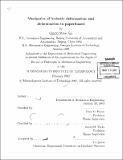Mechanics of inelastic deformation and delamination in paperboard
Author(s)
Xia, Qingxi, 1973-
DownloadFull printable version (20.47Mb)
Other Contributors
Massachusetts Institute of Technology. Dept. of Mechanical Engineering.
Advisor
Mary C. Boyce and David M. Parks.
Terms of use
Metadata
Show full item recordAbstract
Paperboard is one of the most widely used materials. The inelastic deformation of paperboard plays a crucial role during many manufacturing processes (e.g., the converting process whereby paperboard is converted into a product such as a milk carton by punching and subsequent folding) and during in-service applications. There is a scarcity of constitutive models describing inelastic behavior of paperboard under complex loading, despite the paper industry's great need of analytical tools to aid the design and manufacturing of better paperboard products. In this thesis, two constitutive models are developed to model the highly anisotropic, elastic-plastic behavior of paperboard/paper: (1) A three-dimensional elastic-plastic interface constitutive model is developed to model the out-of-plane delamination behavior of paperboard. The onset of interface separation is controlled by a limit surface in the normal-shear traction space. The limit surface is taken to shrink with a monotonically-increasing scalar internal variable reflecting damage associated with the history of inelastic relative interface displacement. (2) A three-dimensional, anisotropic continuum constitutive model is developed to model the in-plane elastic-plastic deformation of paper and paperboard. The proposed initial yield surface is directly constructed from the yield strengths measured in various loading directions and the corresponding ratios of plastic strain components. An associated flow rule is used to model the plastic flow of the material. Anisotropic strain-hardening of yield strengths is introduced to model the evolution of the yield surface with inelastic strain. (cont.) The two constitutive models are implemented into finite element software to enable the simulation of paperboard mechanical behavior under complex, finite deformation. The models are shown to be capable of accurately capturing both the out-of-plane delamination (via the interface model) and the anisotropic in-plane elastic-plastic (via the continuum in-plane model) behavior of paperboard under complex loading. The two models are combined to simulate the mechanics of a converting process (creasing and subsequent folding) of paperboard. The simulations agree well with corresponding experimental observations. In particular, the underlying mechanisms of damage and delamination development during creasing and subsequent folding are predicted well; the macroscopic response of the bending moment vs. bending angle also agrees with experimental data. This research provides physically based three-dimensional material models of the anisotropic, elastic-plastic deformation of paperboard that enable the computational design of paperboard process and product design.
Description
Thesis (Ph. D.)--Massachusetts Institute of Technology, Dept. of Mechanical Engineering, 2002. Includes bibliographical references (p. 233-236).
Date issued
2002Department
Massachusetts Institute of Technology. Department of Mechanical EngineeringPublisher
Massachusetts Institute of Technology
Keywords
Mechanical Engineering.